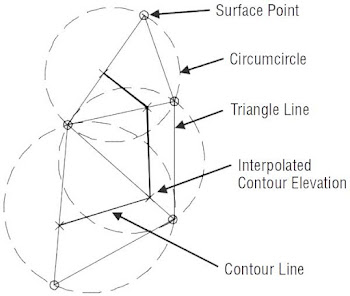TIN surface calculations are based on computational geometry known as Delaunay triangulation. Delaunay triangulation takes a set of points, isolates three in close proximity, and applies a circle intersecting those three points, producing a triangle. This algorithm is repeated for the remaining points, resulting in a collection of circles called circumcircles, which produce a network of triangles. Elevation interpolation occurs along those triangle lines, which determines where contours are drawn.
It’s important that the points used in surface calculations be a good representation of surface elevations. This means that points representing fire hydrants, power poles, or trees, for example, should be excluded since those points more than likely were not collected at ground level.
Other information we provide to a surface definition influences how those triangles are drawn. Breaklines prevent triangle lines from being drawn through them but allow them to be drawn along them. Boundaries prevent interpolation from occurring inside or outside their extents depending on the type of boundary defined. Surface edits can override the Delaunay triangulation. Surface property settings can be used to apply a set of rules governing how the surface is created.

